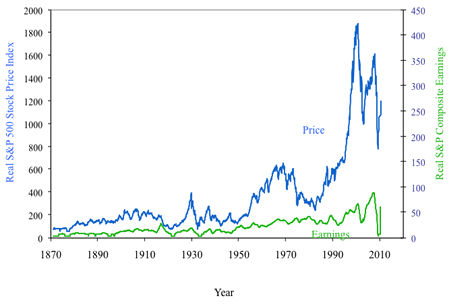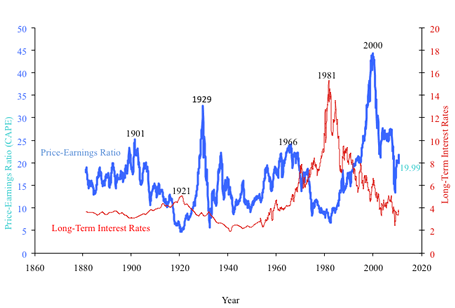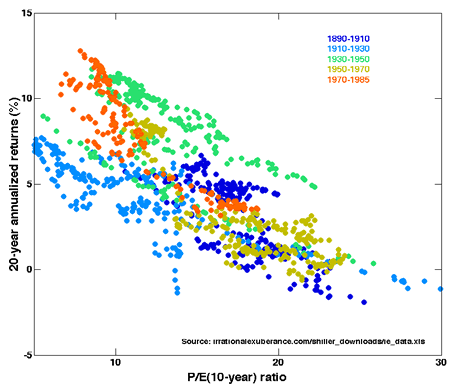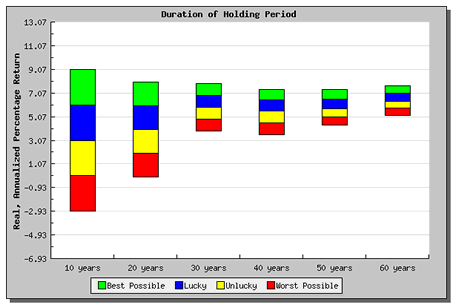As part of gathering the data needed to go beyond net worth, I’ve shown ways to track find your personal savings rate by tracking your current spending with your current after-tax income. For now, I’m skipping ahead to estimating your portfolio’s long-term investment returns.
There are a lot of ways to estimate future stock returns. You’ve probably heard of the P/E ratio, which is usually the price divided by last year’s earnings. This is one measure of “value”. Here is a plot of historical values of the inflation-adjusted S&P 500 index, along with its annual earnings (source).


As you can see, there is a lot of volatility in P/E ratio. The “P/E 10” ratio is the share price divided by the average earnings over the last 10 years. By taking a long-term average, you smooth out the noise and bumps.
Professor Robert Shiller of Yale University, which provided the above data as well, spoke about the usefulness of this ratio in his book Irrational Exuberance, and provided the data for the following chart. The x-axis shows the real “P/E 10” of the S&P Composite Stock Price Index (inflation adjusted price divided by the prior 10-year mean of inflation-adjusted earnings). The y-axis shows the geometric average real annual return of the same index, reinvesting dividends, and selling 20 years later.

You can definitely see the relationship that a higher P/E10 usually leads to a lower future return. However, there is still a great deal of scatter for any given P/E10 ratio.
What about today? As of June 2, 2010 the P/E10 is 19.99 with the S&P 500 index at around 1,098. Historical average is about 15. Back in March 2009 when everything was looking bleak, the P/E10 was 13.32. (P/E10 is also referred to as Cyclically Adjusted Price Earnings (CAPE) ratio.)
The Early Retirement Planning Insights website provides a calculator that forecasts future returns based on the current value of P/E 10, again using historical returns. I’m not sure exactly how they did all the regression. Here’s their return forecast for a P/E 10 ratio of 20.

For a 20-year forecast, it shows an average outlook of 4% returns, on a real (after-inflation) basis. Of course, the range indicates that the actual returns could look much worse. As the time-horizon lengthens, the range gets smaller due to the phenomenon of reversion to the mean. Kind of scary to look 60 years ahead!
Warnings
To me, this stuff is useful as a general Big Picture planning tool, not as a short-term trading tool. These are just predictions based on the past, which is often the best we can do, but still far from perfect. Many people use P/E10 as a tool for market timing, shifting their asset allocation as it rises and falls. Shiller himself states that his plot above:
confirms that long-term investors—investors who commit their money to an investment for ten full years—did do well when prices were low relative to earnings at the beginning of the ten years. Long-term investors would be well advised, individually, to lower their exposure to the stock market when it is high, as it has been recently, and get into the market when it is low.
That may be true, but market timing systems can really test an investor’s faith when they seem to be wrong for a long period of time. On a personal basis, I’d probably limit any asset allocation moves – if any – to if the P/E10 ratio moved to an extreme, for example dropped below 10 or above 25.
 The Best Credit Card Bonus Offers – 2025
The Best Credit Card Bonus Offers – 2025 Big List of Free Stocks from Brokerage Apps
Big List of Free Stocks from Brokerage Apps Best Interest Rates on Cash - 2025
Best Interest Rates on Cash - 2025 Free Credit Scores x 3 + Free Credit Monitoring
Free Credit Scores x 3 + Free Credit Monitoring Best No Fee 0% APR Balance Transfer Offers
Best No Fee 0% APR Balance Transfer Offers Little-Known Cellular Data Plans That Can Save Big Money
Little-Known Cellular Data Plans That Can Save Big Money How To Haggle Your Cable or Direct TV Bill
How To Haggle Your Cable or Direct TV Bill Big List of Free Consumer Data Reports (Credit, Rent, Work)
Big List of Free Consumer Data Reports (Credit, Rent, Work)
Granted market timing is an impossible task but I will say that the P/E ratio of the market is a good indicator of how rich it is at. The problem with trading on P/E ratio alone is the fact that the market can be irrational for many yrs on end & you can find yourself missing opportunities. I personally will miss a few opportunities as I wait for the market to become a more reasonable price to purchase. Good article, thanks!
Market history shows that the great bull markets began after the P/E hit right around 7. Those in the market at this time haven’t done their research, and are listening to the hype from Wall Street, stock brokers, and TV talking heads. It’s very sad that folks can be conned this way.
@Bill – What do you think a more reasonable price is?
@Marc – Perhaps, but are you really willing to wait until the P/E or P/E10 is at seven? That could be a very long time.
Jonathon – You tell me? Do you think it’s a good idea to jump into an expensive market that has very little chance for growth and a huge chance for loss? Why would you want to do that? Even Black Rock says to expect around 4% to 5%, — and no more than up to about 6% if you’re very lucky. Do you want to take such a risk for such a small possible return? Especially when you can do the same or better with no risk at all?
Don’t be bamboozled by this baloney about 10% market averages. That’s only a very tiny piece of the puzzle… but it’s the piece that will suck you in and bleed you dry.
You see, most people don’t realize that there are very safe ways to make a return as great or greater than the market average, with almost no risk at all. People who are in the market now haven’t studied the markets, and don’t know they have better alternatives.
So… to answer your question: Yes, I am perfectly willing to NOT throw my money down a rat hole. My question is… why would you want to?
Nice post.
The Dow will be at 1,830,725 in 60 years. Not a bad advance from its current 10,400. This is if you accept the 6% figure and add 3% annually for inflation.
Gee, Marc, would you like to enlighten the rest of us by letting us know how we “can do the same or better with no risk at all”? I think most of the readers here would love to know about “very safe ways to make a return as great or greater than the market average, with almost no risk at all.”
Sounds wonderful!
Just my two cents: P/E ratio thing only works well for value stock, e.g., established companies like those blue chips. For growth stocks like many hi-tech companies, they tend to have very high P/E but at the same time have huge growth opportunities. For these companies, P/E might not be a good tool. By the way, for the same reason, P/E is very helpful to trade indexes or many mutual funds.
Gee, Naveen, that shouldn’t be too hard. The key is to understand the REAL market average, and NOT the trumped up baloney Wall Street wants you to believe.
The broad market has returned about 4.1% since about 1870 or so. If you add in current dividends of about 2.26%, that leaves you with about 6.36%. With the P/E ratio where it is now (historically very high) you should expect to average between 4% to 6% over the next 20 to 40 years. This is right in line with what Black Rock is saying. Warren Buffet is saying about the same thing.
Since Warren Buffet and Black Rock are two of the the biggest and most influential players in the world today, it’s a pretty safe bet that your local stockbroker won’t be able to do any better, no matter what he or she says. And this is with a huge amount of volatility. There’s no promise that you’ll see that average return in the next 20 years.
Contrary to what many people think, risk does not equal reward… risk equals risk. You may or may not see any reward in your lifetime, depending on your age. Folks in Japan have been waiting for their risk reward for the last 20 years, and they’re likely to be waiting a long, long, time to come.
Given that information, it’s not too hard to find many safe financial instruments that will return that and more, with little or no volatility or risk. No only that, with the right strategy, you can turn that into a guaranteed income for life, indexed for inflation.
Or you can stick your money in the market and hope for the best. Hope is not a very good strategy, especially when the numbers are so strongly against you.
Marc
Jonathan- I feel that a more reasonable P/E level on the S&P of 13 and a div yield of 5% is a good signal you are getting in at acceptable levels. An interesting chart to look at some time is the Dow in 1900 thru today, in the mid 80’s the chart almost goes vertical. I will say that there were some big economic expansions occuring such as lower tax rates, technology advances & upward mobility on a global scale which means more savings, investements etc. to account for this: to a point. You just have to wonder when the invisible hand will realize that the market has been priced beyond reality and will trade at a fair value price.
Nice Charts. Since 1950’s or so the dividend payments have been much less volatile than earnings and stock prices. Which is why i focus on dividends ( well 2008-2009 was out of the norm).
The thing about P/E ratios is that they present earnings as if they are static. The truth is that earnings are increasing over time ( not every year, but if you look at it at a decade by decade snapshots you will see what I am saying). Thus while you might be paying 20 times 2010 earnings for S&P 500, 10-12 years from now earnings would be double what they are today… If S&P 500 is still trading at the same levels as today, the P/E would be 10. As a holder of S&P 500 however you would have certainly received dividends and hopefulyl reinvested them…
@Marc – You sort of contradict yourself in saying there is risk, but then putting a whole lot of stock in the prediction of 4-6%. If you feel that number is that solid, then how is there risk in it? Realistically, there is just as much of a chance it will be 2% or 8%.
My take… The past is some sort of indicator, but the day before the internet was created the USPS sure had a pretty strong history of being the primary mover of information. The unexpected can and will happen.
You cant predict the future of any investment, period. North Korea fires a few nuclear missles tomorrow and everything changes. At the end of the day we are all picking the data that seems most useful to us and hoping it all works out. To think you are somehow wiser than the other 6 billion people on this planet is a bit arrogant.
@ Johnathon – this is one of the better posts in a while – I really enjoy these in depth reviews. Thanks for this, and thanks to Mrs MMB for letting you spend so much time staring at numbers.
@Marc – you still did not elaborate on “very safe ways to make a return as great or greater than the market average, with almost no risk at all.”
My guess what Marc is referring to with higher returns, less risk would be annuities, equity indexed, fixed etc.
lottery tickets (no risk, you know you are out the $1).
@ ChrisMR – No contradiction at all, my friend. If you read my post, you’ll see I clearly stated there are no guarantees that anyone will ever hit any average. Over the next 20 to 40 years, the market could average 2%, 8%, or -3%. No one knows. I also pointed out that Japan has been waiting for 20 years to see any real gains, and are likely to wait a long time. So, though I dared to hazard an educated guess based on 139 years of history, I never said it was a given. In fact I said just the opposite. Nor did I ever imply that I am any wiser than my 6 billion fellow earthlings. Where in the world did you get that?
@ Bill – I think the levels you mentioned would offer a very reasonable opportunity for long-term gain. You make many good observations. I think there is more to it than that, and I bet we could have a fun conversation about it all.
I like this thread. The original post, and the comments, offer a lot of good information investors need to consider before investing.
– And, yes, I’m referring to guaranteed insurance contracts of all sorts. There many different types, and many different ways of using them that could get you the long-term market averages with very little risk. And you can parlay them into guaranteed lifetime income that should do much better than the conventional methods in vogue right now.
I’m enjoying the thread also. What is the upside to these guaranteed insurance contracts, Marc? Is there a chance that they could significantly outperform the market? What exactly is the insurable interest, and how can one profit from them? Is it possible to engage in buying and selling them without paying confiscatory commissions to salespeople? What is the minimum investment required? Do they have good liquidity?
Naveen, the first thing you have to consider is annuities are supplemental retirement products and have the same stipulations such as tax deferral, under 59 1/2 early withdrawal penalties that is why it makes little sense to put an annuity into an IRA unless you are getting one heck of a guaranteed yield. Annuities make more sense for high income earners that have maxed out all other retirement vehicles and feel they could be in a lower tax bracket when they are older. If you want to switch annuity co.s you will have to do a 1035 exchange to avoid taxes.
Personally, I am not an annuity fan as they are usually very expensive and like any insurance product, are designed to line the insurance co.s pockets. Take an equity indexed annuity, it will be tracked with the S&P and have a percentage cap and a zero loss. The cap may be 6% so if the S&P rises 10% you’ll get 6% but if the S&P is flat or negative you will get no return but suffer no loss.
Again, for younger investors you can take the extra risk and buy the index yourself which is very tax efficient and reap the benefits of the market rising beyond what the annuity will pay out. Think about it, what are the insurance co.s doing to make a profit?
Marc can correct me if am wrong on any of these points. I have not had a lot of free lunches myself.
Naveen, I’ll try to answer your questions, and address Bob’s points at the same time. A bit tricky, but here goes:
1) The upside to guaranteed contracts is that they are guaranteed. You can’t lose your principle and you can have an income guaranteed to life. If you do it right, that income can hedge against inflation.
2) Significantly outperform the market? Heck, a CD at your local bank outperformed the market for the last 12 years, including dividends. I’m afraid that phrase is meaningless. No one knows what the market will do, so who can say what we need to outperform. However, some of these are on a par with the 139-year market average, and some do much better… with no volatility and no risk to principle.
3) There is no insurable interest unless you are talking about life insurance. Life insurance is usually not very good for retirement money unless you have a LOT of money, then it’s a great thing… but only if properly structured.
4) These are to be looked at as long-term contracts. You don’t jump in and out of these like mutual funds. They are not for trading (a losing venture, BTW)
5) There are no commissions or fees that come out of your money, unlike mutual funds, which are loaded with fees. Commissions are paid by the company, not by the client. And think about it… you buy a house, a car, groceries, gasoline, clothes, car insurance, etc. On every one of these things you paid a commission or a markup. That’s the way of the world. Don’t shortchange yourself because you don’t want to pay someone for their expertise. There’s a reason the wealthy pay for advice.
6) They are as liquid as anything else. There’s nothing of value that is totally liquid at all times. You need to understand why you are doing something, and then you’ll know if the degree of liquidity meets your needs.
Now Bob,
7) These are not only supplementary, unless social security is your primary income source, or if you are fortunate enough to have a pension. The fact is, these make a very good substitute for a company pension, and many folks use them as their primary source of income.
8) Many very intelligent and sophisticated investors put these in their IRAs. Tax deferral isn’t the only reason to have these things. Tax deferral isn’t granted by the insurance company, it’s granted by the government.
9) Just as with all things in life, there are the good and the not-so-good. It’s the same with annuities. There are annuities with caps, and there are those without caps. They are not expensive at all, unless you are talking about variable annuities, which can be very expensive, and risky.
10) Insurance companies line their pockets? And Wall Street doesn’t?Mutual funds don’t? The real issue isn’t how much profit a person or a company makes… it’s what they can do for you that counts.
Remember, in the end, the only thing that matters is if you are better off than you were before. Everything else is just talk.
Annuities are much maligned by the popular press and the Wall Street crowd. I’m sure you can figure out why.
If you want to really understand these things, read Professor David Babbel from the Wharton School of Finance, and Professor Zvi Bodie from Boston University. They are big fans of annuities. If you read the latest research on retirement planning you’ll see why.
Don’t be mislead by the popular press and “common wisdom.” Remember that at one time, everybody “knew” that the earth was flat.
Sorry to be so long-winded, but you asked. My wife has learned not to ask me anything unless she wants a very complete answer :o)
And in the interest of full disclosure, I am a comprehensive financial planner, and a Registered Investment Advisor. I work with these sorts of things all the time, and I know them very well. I probably study way to much, but I love this investment stuff. I’m sure you all do, too. That’s why you’re here.
Marc